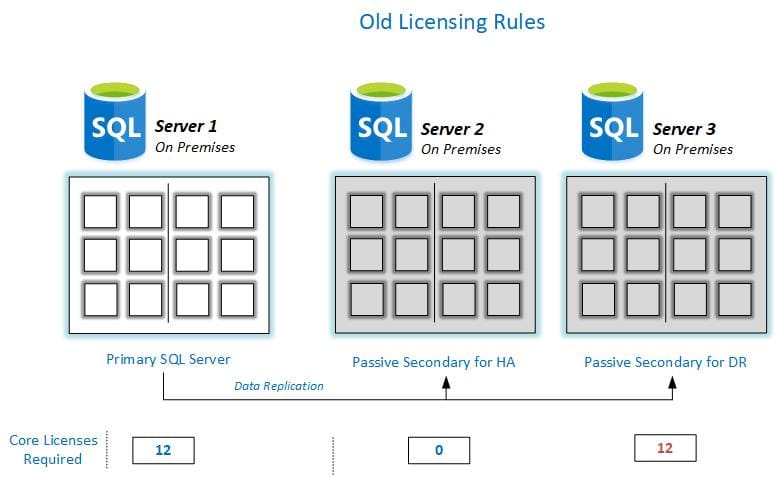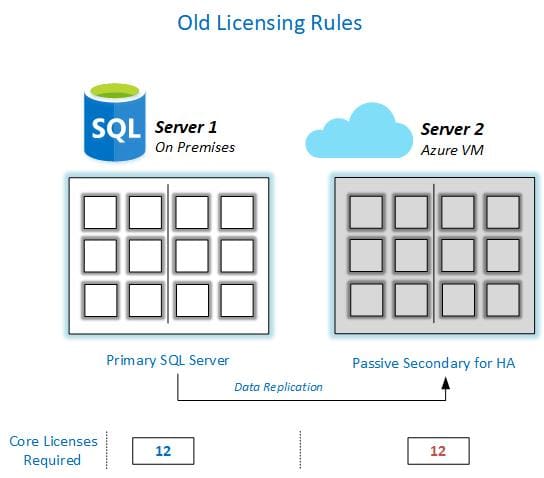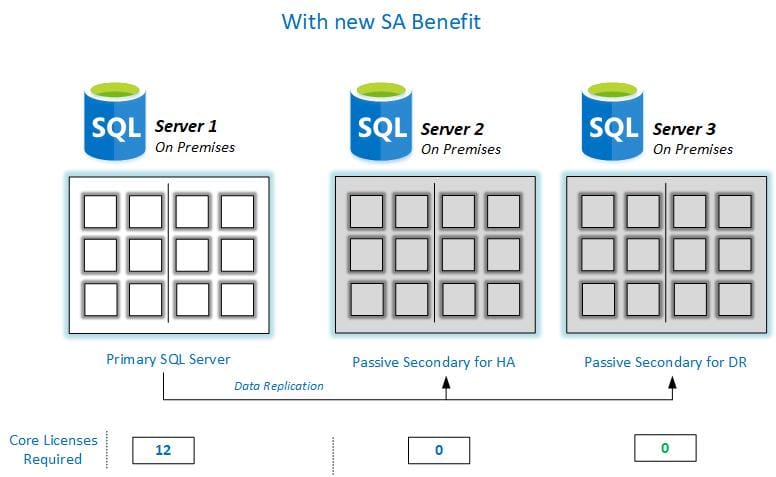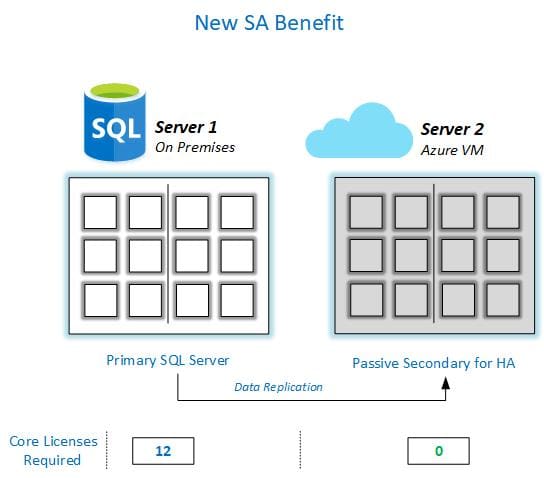SQL Server Software Assurance Benefits: High Availability & Disaster Recovery Improvements
New changes for SQL Server High Availability and Disaster Recovery
Microsoft recently announced important updates to SQL Server Software Assurance benefits, improving support for High Availability (HA) and Disaster Recovery (DR). These licensing improvements help organisations reduce costs while strengthening SQL Server resilience, both on‑premises and in Azure SQL VM hybrid deployments.
Organisations with SQL Server and SA coverage are now able to utilise up to two passive SQL Servers at no additional cost and therefore make significant, as well as cost effective, business continuity improvements to their critical database infrastructure.
Historically, the SA benefit allowed for just one passive SQL Server to be licensed at no additional cost for use in a High Availability scenario when licensing a primary server located on premises. Additional core licenses were required to license any extra servers required for Disaster Recovery, or for databases replicated to an Azure SQL VM. This posed a significant license cost for businesses that required low recovery time and recovery point objectives.
For many organisations, the total cost of ownership (TCO) for SQL Server in this scenario is very high, especially when the passive instance may never be used. For this reason, many organisations rely on third party tools, hypervisor availability function, SAN replication or basic SQL Server technologies to provide a level of disaster recovery which may provide a very long recovery time and sub optimal recovery point objectives.
For organisations who cannot afford the infrastructure investment to implement a second data centre, using Azure offers a cost-effective solution, but not when replicating SQL Server databases to an Azure SQL VM, where historically no passive license benefit was offered.
New SQL Server Software Assurance Licensing Benefits
The following two diagrams show the old licensing rules which were required when licensing a typical on premises SQL configuration utilising one local and one remote replica, and the licenses required when replicating to an Azure SQL VM:


With the new SQL Server Software Assurance improvements, Microsoft now allow up to two passive servers at no additional cost. Organisations are now free to implement a complete High Availability and Disaster Recovery architecture for their critical databases, without having to pay extra for the privilege.
With the option to replicate data to an Azure SQL VM, also at no additional license cost, the barrier to explore hybrid architectures has been removed.
The following two diagrams show the new SA benefit for the same architecture design highlighted earlier:


One additional benefit Microsoft have provided with this change is that it isn’t available just for the latest version of SQL Server. This SA Benefit improvement is retrospective to all supported versions of SQL Server meaning anyone running SQL Server 2012 and up can take advantage of these changes.
The Fine Print: SQL Server Software Assurance Licensing Rules
This SQL Server Software Assurance Benefit change seems too good to be true, and it mostly is, however, to be fully compliant with these license changes there are several terms and conditions which must be adhered too.
- Software Assurance must be purchased and associated with the SQL Server and CAL licenses, or the SQL Server Core licenses, which will be used to improve the HA and DR capabilities.
- The same number of SQL Cores licensed on the primary server must be the same on each secondary replica.
- Each replica must be completely passive and only used for High Availability or Disaster Recovery workloads. If you have multiple Availability Groups on the primary replica, then each secondary node must be licensed, as Availability Groups could operate in any of the secondary replicas. Alternatively, configure just one Availability Group for all databases so that only one replica runs production workloads at a time.
- Disaster Recovery replicas are defined as replicas which use asynchronous replication and manual failover.
- Passive nodes can be used to run certain operations: Database consistency checks, log backups, full backups and monitoring resource usage data only.
- The new SA Benefit applies to all supported editions of SQL Server, except Parallel Data Warehouse.
Understand and Improve your SQL Server Availability Options with Ultima
With these new changes, there is now a cost-effective way to instantly improve the High Availability and Disaster Recovery capabilities of your SQL Server infrastructure, with little financial penalty. Ultima can assist your organisation with the ability to assess, design and implement the right solution for your requirements.
Ultima provides several Professional Services engagements to support your database business continuity needs:
- SQL Server High Availability and Disaster Recovery Assessment: Understand your database business continuity state and options for improvements.
- SQL Server Consolidation Assessment: Identify how you can save on licensing and infrastructure costs by consolidating existing data workloads.
- SQL Server Migration Assessment: Upgrade and move your existing databases to a new and supportable platform and take advantage of the latest SQL Server features, availability functions and performance enhancements.
- Hybrid Cloud Engagement: Utilise Azure Backup and SQL Server Azure Disaster Recovery capabilities and provide the first steps to migrating your data estate into the cloud.
Please speak with your Ultima Account Manager or contact us if you would like to discuss any of these options further.
—
Frequently asked questions
Microsoft has updated SQL Server Software Assurance (SA) benefits to include up to two passive SQL Server replicas at no additional licensing cost. This enhancement improves High Availability (HA) and Disaster Recovery (DR) strategies, helping organisations reduce costs while increasing resilience.
With the new SQL Server Software Assurance changes, organisations can run multiple passive replicas for both HA and DR scenarios without buying extra core licenses. This makes it easier and more cost-effective to achieve low Recovery Point Objectives (RPO) and Recovery Time Objectives (RTO).
Yes. The updated SQL Server Software Assurance benefits allow customers to replicate databases to an Azure SQL VM without paying for additional passive licenses. This opens the door for hybrid cloud architectures that combine on-premises and Azure-based deployments.
These licensing improvements are retrospective for all supported versions of SQL Server, starting from SQL Server 2012 up to the latest release. That means any organisation with active SA coverage can take advantage of the new benefits.
- Have active Software Assurance coverage for SQL Server and CAL/core licenses.
- License the same number of cores on the secondary replicas as the primary server.
- Ensure replicas remain fully passive, only used for HA or DR workloads (not production).
Microsoft has updated SQL Server Software Assurance (SA) benefits to include up to two passive SQL Server replicas at no additional licensing cost. This enhancement improves High Availability (HA) and Disaster Recovery (DR) strategies, helping organisations reduce costs while increasing resilience.
With the new SQL Server Software Assurance changes, organisations can run multiple passive replicas for both HA and DR scenarios without buying extra core licenses. This makes it easier and more cost-effective to achieve low Recovery Point Objectives (RPO) and Recovery Time Objectives (RTO).
Yes. The updated SQL Server Software Assurance benefits allow customers to replicate databases to an Azure SQL VM without paying for additional passive licenses. This opens the door for hybrid cloud architectures that combine on-premises and Azure-based deployments.
These licensing improvements are retrospective for all supported versions of SQL Server, starting from SQL Server 2012 up to the latest release. That means any organisation with active SA coverage can take advantage of the new benefits.
- Have active Software Assurance coverage for SQL Server and CAL/core licenses.
- License the same number of cores on the secondary replicas as the primary server.
- Ensure replicas remain fully passive, only used for HA or DR workloads (not production).

